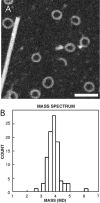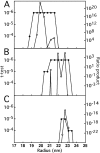HIV-1 rev depolymerizes microtubules to form stable bilayered rings
- PMID: 10908577
- PMCID: PMC2180222
- DOI: 10.1083/jcb.150.2.349
HIV-1 rev depolymerizes microtubules to form stable bilayered rings
Abstract
We describe a novel interaction between HIV-1 Rev and microtubules (MTs) that results in the formation of bilayered rings that are 44-49 nm in external diameter, 3.4-4.2 MD (megadaltons) in mass, and have 28-, 30-, or 32-fold symmetry. Ring formation is not sensitive to taxol, colchicine, or microtubule-associated proteins, but requires Mg(2+) and is inhibited by maytansine. The interaction involves the NH(2)-terminal domain of Rev and the face of tubulin exposed on the exterior of the MTs. The NH(2)-terminal half of Rev has unexpected sequence similarity to the tubulin-binding portion of the catalytic/motor domains of the microtubule-destabilizing Kin I kinesins. We propose a model wherein binding of Rev dimers to MTs at their ends causes segments of two neighboring protofilaments to peel off and close into rings, circumferentially containing 14, 15, or 16 tubulin heterodimers, with Rev bound on the inside. Rev has a strong inhibitory effect on aster formation in Xenopus egg extracts, demonstrating that it can interact with tubulin in the presence of normal levels of cellular constituents. These results suggest that Rev may interact with MTs to induce their destabilization, a proposition consistent with the previously described disruption of MTs after HIV-1 infection.
Figures






Similar articles
-
Structural basis of microtubule depolymerization by the kinesin-like activity of HIV-1 Rev.Structure. 2023 Oct 5;31(10):1233-1246.e5. doi: 10.1016/j.str.2023.07.009. Epub 2023 Aug 11. Structure. 2023. PMID: 37572662 Free PMC article.
-
A human nucleoporin-like protein that specifically interacts with HIV Rev.Nature. 1995 Aug 10;376(6540):530-3. doi: 10.1038/376530a0. Nature. 1995. PMID: 7637788
-
Comparative analysis of Rev function in human immunodeficiency virus types 1 and 2.J Virol. 1992 Jul;66(7):4288-94. doi: 10.1128/JVI.66.7.4288-4294.1992. J Virol. 1992. PMID: 1602545 Free PMC article.
-
Tubulin rings: which way do they curve?Curr Opin Struct Biol. 2003 Apr;13(2):256-61. doi: 10.1016/s0959-440x(03)00029-0. Curr Opin Struct Biol. 2003. PMID: 12727521 Review.
-
The HIV-1 Rev protein.Annu Rev Microbiol. 1998;52:491-532. doi: 10.1146/annurev.micro.52.1.491. Annu Rev Microbiol. 1998. PMID: 9891806 Review.
Cited by
-
Early steps of retrovirus replicative cycle.Retrovirology. 2004 May 14;1:9. doi: 10.1186/1742-4690-1-9. Retrovirology. 2004. PMID: 15169567 Free PMC article. Review.
-
Activity of the human immunodeficiency virus type 1 cell cycle-dependent internal ribosomal entry site is modulated by IRES trans-acting factors.Nucleic Acids Res. 2011 Aug;39(14):6186-200. doi: 10.1093/nar/gkr189. Epub 2011 Apr 10. Nucleic Acids Res. 2011. PMID: 21482538 Free PMC article.
-
Microtubule Dynamics may Embody a Stationary Bipolarity Forming Mechanism Related to the Prokaryotic Division Site Mechanism (Pole-to-Pole Oscillations).J Biol Phys. 2004 Jan;30(4):325-44. doi: 10.1007/s10867-004-3387-7. J Biol Phys. 2004. PMID: 23345876 Free PMC article.
-
Discovering regulated networks during HIV-1 latency and reactivation.Pac Symp Biocomput. 2006:354-66. Pac Symp Biocomput. 2006. PMID: 17094252 Free PMC article.
-
Generation and use of antibody fragments for structural studies of proteins refractory to crystallization.Methods Mol Biol. 2014;1131:549-61. doi: 10.1007/978-1-62703-992-5_35. Methods Mol Biol. 2014. PMID: 24515490 Free PMC article.
References
-
- Auer M., Gremlich H.-U., Seifert J.-M., Daly T.J., Parslow T.G., Casari G., Gstach H. Helix-loop-helix motif in HIV-1 Rev. Biochemistry. 1994;33:2988–2996. - PubMed
-
- Bai R., Taylor G.F., Schmidt J.M., Williams M.D., Kepler J.A., Pettit G.R., Hamel E. Interaction of dolastatin 10 with tubulininduction of aggregation and binding and dissociation reactions. Mol. Pharmacol. 1995;47:965–976. - PubMed
-
- Bai R., Schwartz R.E., Kepler J.A., Pettit G.R., Hamel E. Characterization of the interaction of cryptophycin 1 with tubulinbinding in the Vinca domain, competitive inhibition of dolastatin 10 binding, and an unusual aggregation reaction. Cancer Res. 1996;56:4398–4406. - PubMed
-
- Bai R., Durso N.A., Sackett D.L., Hamel E. Interactions of the sponge-derived antimitotic tripeptide hemiasterlin with tubulincomparison with dolastatin 10 and cryptophycin 1. Biochemistry. 1999;38:14302–14310. - PubMed
-
- Battiste J.L., Mao H.Y., Rao N.S., Tan R.Y., Muhandiram D.R., Kay L.E., Frankel A.D., Williamson J.R. Alpha helix-RNA major groove recognition in an HIV-1 Rev peptide RRE RNA complex. Science. 1996;273:1547–1551. - PubMed
Publication types
MeSH terms
Substances
Grants and funding
LinkOut - more resources
Full Text Sources
Medical

